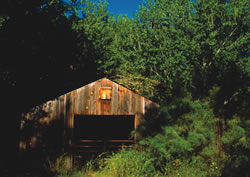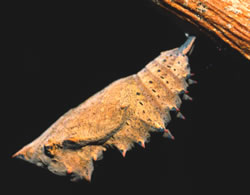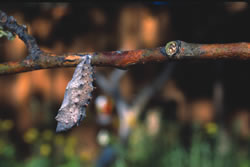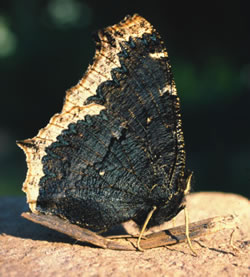The
weather shouts “March!” as last week’s
snowstorm melts into the warmth of today. Spring has
sprung, as red-winged blackbirds sing, cottonwood buds
seem ready to burst, and the first butterflies of spring,
the mourning cloaks, bask in the morning sunshine.
Gathering warmth through their dark wings, these butterflies are
named after the traditional woolen cloaks or coats worn back in
the 1800s while someone was “in mourning”. In Europe
and Eurasia, where this species also occurs, these butterflies
are known as Camberwell Beauty, after their initial discovery in
1748 near Camberwell, London. For when the light strikes their
purplish-black wings, they are indeed beautiful creatures.
A thick yellow to tannish band borders the margin of the wings
and is visible when the wings are folded open. Inside of this border
is a row of iridescent blue spots. These spots are barely visible
when the butterfly folds its wing up, and the irregularly scalloped
margin helps the butterfly blend into its surroundings. Camouflaged
against a tree trunk or the ground, these medium-sized butterflies
may be overlooked.
But in the spring, they stand out when in flight because they are
the only butterflies about. These early season adults are those
that overwintered, hiding beneath a flake of bark or a rotting
log or perhaps some loose siding. Depending upon their location,
as these butterflies occur throughout North America except for
the Gulf States and Florida, these adults seek mates before they
die.
Instead of flying all about, the males tend to sit and wait for
receptive females to fly into their territory. After courtship,
the females lay numerous eggs (20-50) in loose groups on host plants
that include willows, elms, hackberries, cottonwoods, aspens, and
birches. The eggs hatch in concert with the spring leaves, thus
ensuring an ample food supply for the caterpillars. Often a swarm
of caterpillars will be encountered.
The caterpillars tend to congregate on plants until they are much
older and start dropping from the trees and dispersing. Then the
caterpillars might be observed singly or in small groups. The caterpillars
are easy to identity as their dark bodies have numerous bottlebrush-like
hairs projecting from reddish bases. The coloration and presence
of the hairs is to deter predators – mostly birds – from
consuming the individuals.
The young caterpillars go through several growth stages and shed
their skin with each stage. In late spring the caterpillar will
spin a short section of silk that enables them to hang downwards
from a limb or protective overhang. Looking like an inverted J,
the caterpillar enters into its final adolescent stage, the chrysalis,
where it turns into the proverbial beautiful butterfly.
This metamorphoses period takes about two weeks, but not all of
the grayish chrysalises mature. Those adults that do survive emerge
from their pupas and find a safe location to dry their wings. Sometimes
afterwards, which might be weeks away, the adult will enter into
a temporary hibernation called aestivation. Afterwards the adults
will emerge and feed prior to winter.
Though the butterflies feed mainly on tree sap, you can place a
plate of rotting bananas, melons or peaches out to attract adults
to your yard. Though these butterflies will drink nectar from flowers,
this behavior is the oddity, not the norm. Sometimes you might
encounter one of these adults walking head downward along a tree
trunk searching for a wound or woodpecker hole from which sap is
flowing.
So if you encounter one of these long-lived butterflies, give them
a break. They have endured the tests of winter only to begin the
trials of spring - a condition that led to their official designation
as the Montana State Butterfly in 2001.
|





|